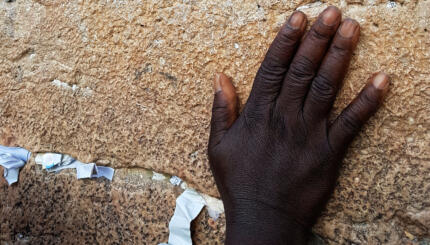Excerpted with permission from Discovering Jewish Music (Jewish Publication Society).
The Jews of Renaissance Italy enjoyed intermittent tolerance by various rulers of the autonomous city-states that dotted the northern province. Many achieved prominence as court instrumentalists, singers, dancers, and actors. Salamone Rossi (ca.157O-ca.1628) was the last and most distinguished example. In 1587, he began his long association with the Gonzagan Court, initially as a singer and violist. He soon became the leader of Duke Vicenzo I’s court musicians and directed an instrumental ensemble probably composed of Jewish musicians. He also became a leading composer, pioneering the musical form known as the trio sonata.
Rossi’s great claim to Jewish musical fame came with his publication in 1623 of Ha-Shirim Asher li-Shelomo, a collection of 33 Psalms, hymns, and other liturgical poems set for combinations of from three to eight voices and intended for use on festive synagogue occasions. In publishing these works, Rossi relied heavily on the endorsement of his friend Rabbi Leon (Judah Aryeh) Modena. Modena (1571-1648) had issued a responsum [a rabbinic ruling] in 1605 that, after years of prohibition, provided halakhically [legally] derived approval for the performance of choral works in the synagogue. Modena’s own choir at his synagogue in Ferrara seems to have established a precedent. But how did the music sound?
Abandoning Traditional Melodies
There are at least six musical traditions among the various Jewish communities of Italy, including variations of Ashkenazic [East European-descended] and [Spanish-descended] practices. While there are substantial differences among them, all share an Eastern cast. In Rossi’s day, this Eastern orientation precluded harmonization according to the prevailing Western styles. Rossi was faced with two choices: Give up his goal of creating art music for the synagogue or abandon the traditional nusah [musical motifs that distinguish each synagogue service] that limited his musical options. Rossi chose the latter.

Help us keep Jewish knowledge accessible to millions of people around the world.
Your donation to My Jewish Learning fuels endless journeys of Jewish discovery. With your help, My Jewish Learning can continue to provide nonstop opportunities for learning, connection and growth.
|
Sample the TunesClick to listen to samples of Rossi’s work, as performed by the Zamir Chorale of Boston:
Links courtesy the Zamir Chorale of Boston. |
An initial hearing of Rossi’s music confirms the impression that Rossi “sold out” to the conventions of his day. Worse, most lay listeners would assert that his music sounds like “church music.” Since much of the extant music of the period was, in fact, composed for the church (and since many contemporary churches–as well as secular choral societies–continue to perform this repertoire), this impression is not without foundation. However, bearing in mind not only the restrictions under which Rossi worked, but also the assumption that music of the Jews has always borrowed from the surrounding culture, it is only fair to take a second look at the claim that Rossi has indeed written “Jewish music.”
Rossi’s Texts
First, let’s examine Rossi’s texts. If we are willing to accept songs of warrior maidens as Jewish simply because they are sung in Ladino, then we must certainly give Rossi credit for setting traditional Jewish texts. One could argue that anything intended for use in the synagogue or Jewish ritual life must be Jewish, no matter what it sounds like. All 33 of the selections in Ha-Shirim Asher li-Shelomo pass this test.
There are [many] examples of Rossi’s special settings of his Jewish texts. Taking just one, we can look at the opening bars of his Psalm146. Halleluyah, the first word of the text, is actually a combination of two words: hallelu (“Praise” in the tzivu’i, or commanding tense) and “Yah” (one of many names for the Divine). Rossi’s psalm is set in the key of A minor. If we accept the stereotypical notion that the minor mode is a “sad” one, then we should certainly switch to the “happy” major mode for the enunciation of God’s name–and that is exactly what Rossi does.
Barekhu: Call to Prayer
There is one more of Rossi’s compositions that merits discussion here: his setting of Barekhu. This selection consists of a one-line “call to prayer” that announces the official start of the service proper, followed by the congregation’s response to the leader’s call:
Leader: Barekhu et hamevorakh
Bless the LORD, the blessed One.
Cong.: Barukh Adonai hamevorakh leolam va’ed
Blessed is the LORD, the blessed One for all eternity.
Although the traditional nusah for this passage varies from one occasion to the next, the precentor’s line is always extended, literally calling the faithful to prayer with a drawn-out invitation (lest the call be so brief that one might miss it). The Ashkenazic custom for Sabbath evening is to chant an especially melismatic rendition.
The congregation’s response, on the other hand, is normally a perfunctory, syllabic chant, reflecting the obedient acceptance of the charge to praise God (as well as the more limited musical ability of the typical congregant).
Rossi’s composition is in two very different sections. The precentor’s “call to prayer” is melismatic and polyphonic. Melismatic phrases (interestingly, a frequent attribute of Eastern music) were part of the normal order of performance during the Renaissance; individual words were exaggerated through elongated articulations of several notes for each syllable of text. The polyphonic (literally, “many sounds”) style allowed each vocal line its own integrity; each part is musically interesting to the singer and listener, and no one part predominates over the others. The result is a layering of musically equal, semi-autonomous lines.
The one moment of this opening section in which Rossi abandons both melisma and polyphony is in his setting of the word Adonai. There is only one God, and that Name must be clearly enunciated to all; even Renaissance convention allowed for clear articulation of certain texts. Notwithstanding his desire to create beautiful music, the purpose of Rossi’s composition was to set a prayer text, and like all good liturgical composition, his music is always subservient to the meaning of the text.
The musical alternative to polyphony that Rossi uses in his setting of God’s name is “homophony” (literally, “same sound”). This style distinguished the Baroque era in the same way that polyphony characterized the Renaissance. Homophony also distinguishes the second section of Rossi’s Barekhu from the first. The worshipers respond to the precentor’s call to prayer in a clipped, syllabic chant. The congregation is as unschooled and unrehearsed in musical chant as the precentor is expert.
Rossi exploits the emerging new style to distinguish the choral “congregation” from the preceding “precentor” and utilizes the homophonic style throughout the second section of the composition-that is, until he reaches the text le-olam va’ed, “for all eternity” (or as some translate this text, “forever and ever”). Child of the Renaissance that he is, Rossi cannot resist the urge to paint these words literally, and so he not only reverts to a more polyphonic style but repeats these words, not “forever” but three times–more than enough to make his point.
Rossi’s selection of this particular text for choral performance might be considered as inappropriate inasmuch as it seems to remove the traditional roles from both precentor and congregation; in fact, it appears to render both parties mute as the chorus takes over. Unfortunately, there is little information extant regarding the manner in which this piece–or any of the other Ha-Shirim–wasperformed. It is likely, though, that the hazzan [cantor]participated as a member of the choral ensemble, thus fulfilling his accustomed role.
Rossi’s Scores
Additional insight on this subject can be gleaned from careful examination of Rossi’s scores. In his setting of Barekhu, Rossi notates a double bar at the conclusion of the “leader’s” (polyphonic) passage, before the entry of the choral “congregation”–a clear indication of an intended break in the music.
This is consistent with Rossi’s practice in another setting that would normally involve congregational participation: the Sephardic Kedushah (known as Keter),in which the composer repeatedly stops the music with that same double bar and even refrains from setting texts that the congregation would have been accustomed to singing. It now becomes apparent that Rossi had no intention of appropriating the congregation’s role in the service but, rather, of enhancing those portions where the precenter would have chanted alone.
Similarly, in his setting of Barekhu, while Rossi distinguishes the style of chanting that the precenter and congregation would typically have employed, he does not appropriate the congregation’s accustomed role. Instead, the choral “response” would have followed the congregation’s own chanting of Barukh Adonai hamevorakh.
In this one, short selection, we can see Rossi, the master composer, standing at the end of one musical era, (the Renaissance) and the beginning of the next (the Baroque). We also see Rossi, the proud, knowledgeable Jew, making an important contribution to the Jewish community of his day and to Jewish music history as well.
Ordinarily, when one creates something of lasting import, it is imitated by others and becomes the subject of innovation and improvement in generations that follow. What impact did Rossi’s music have on future Jewish composers? In the short term, none at all. All trace of Rossi disappears in or about 1628, when his last collection of songs was published. Despite the assertion (in Modena’s introduction to the collection) that the Ha-Shirim was variously suitable for performance in the synagogue, the study hall, the house of a bride and groom, and private homes, there is no clear indication that any of the Ha-Shirim were regularly used in this way even during Rossi’s time, let alone in the absence of the composer’s urging and encouragement.
Whether overnight or somewhat more gradually, Rossi’s music faded from practice. In fact, were it not for the chance 19th-century discovery of a complete set of Rossi’s part books, all knowledge of Rossi’s contribution to Jewish music might well have disappeared.


